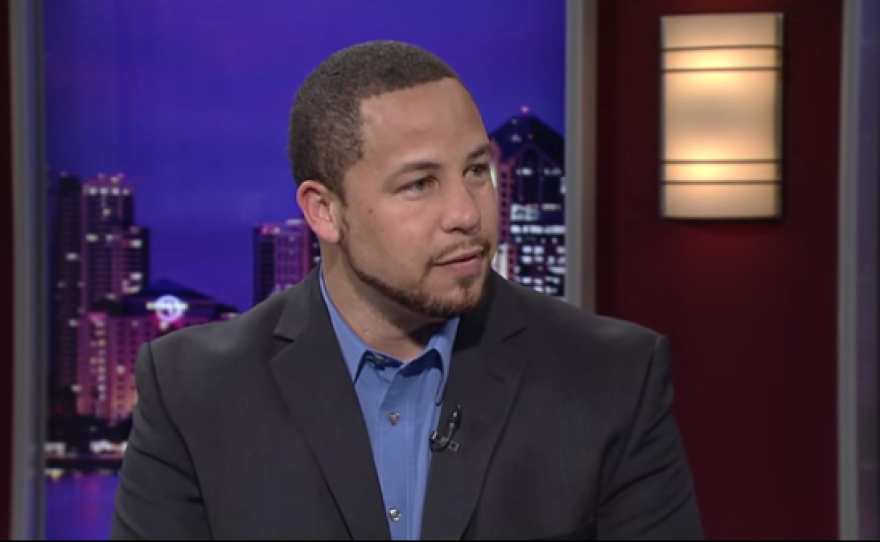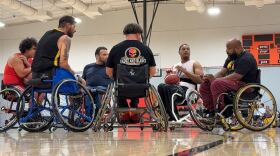This is KPBS Midday Edition, on Maureen Cavanaugh. The pre-Court Justice Antonin Scalia shot the nation last week when he suggested that many male black students might be better in lesser schools. The education gap turns out to be a lot more than that. To San Diego professors the limiting factors are responsible for the high dropout rate in community college. They've come up with a course to teach instructors how to help men of color succeed in school. Joining me is Doctor Luke wood professor of San Diego State University and one of the educators who don't the course. Welcome to the program. Sim Barhoum on is a professor at San Diego Mesa College and he took the course. Welcome. Thank you. What was your reaction? Is comment really centered that the schools and sawhorse over schools. In his mind those schools were less tedious -- prestigious schools and therefore slower. He has a critical ear and that he does not understand what those schools do that make them different. Are not high-performing when it comes to schools of with those of color, they have institutional missions that are focused on serving those students. They had programming designed for those student populations. They had faculty members were hired and trained to do work with diversity learners. It is not because they are slower, it is because the schools are different. I see. Overall. If you could delineate the problem. What are the statistics on the success rates of black men in community college? We know that in a three-year timeframe only 17% of them will or a certificate, degree, or transfer. Back and that is compared with? With white males. If you bring out the national level looking at six your timeframe or even more differences, more than deals with the college educators themselves are woefully unprepared to work with these populations. What people do as they teach how they were taught. If you went to school and you were taught a certain way, that is I think you were supposed to be taught. How they were taught is not necessarily how their students learn. Some of the life experiences don't match with the students their teaching. What kinds of experience are men of color likely to have had in their lives that will be found in the general community college population? We know this population is vastly different than other community college students. They are typically conference concentrated in K-12 schools that are underperforming and these guys experience extreme external life pressures. In our work we measure trestle life events. On average, -- stressful life events. Those include divorce in the family, eviction, relationship breakup, death of a family member or friend. There are unique experiences they have. Masculinity plays a role in this as well. They are socialized not perceive themselves as academic. If you look at a demographic teacher who is white and female. That is not reflective of these men. On the occasion school, we have to sacrifice their identity to be successful. With a something else the terms of this population their school experience and more specifically the experience in community college? It involves the educators networks with them. It is not about what turns them off as what is needed to turn them on. There is about 12 primary intervention areas that faculty need to be able to support this population. We note that for example validation, they need to hear the messages that you can do it, you belong here. I believe in you. They need to be exposed to faculty members who have high expectations for their performance. They need to have faculty numbers who recognize that before the teaching and learning, it does not matter how good your curriculum is. It doesn't matter how much you prepare for the lecture, if you do not have a relationship with these guys, they will not from you. There are a number of areas we identify the is critical for this population. I was surprised to learn that many lack students the their instructors don't like them. That is a common experience we see many of them believe their instructors do not like them or want them there. What we see nationally, I am sure you are familiar with wife's matter. That has been about the criminalization of black men nationwide those same experiences that result in that black men being slain, are the same experiences they have in college, but it plays out slightly different. Faculty members may be apprehensive to engage with the students because they fear them. They may not want to meet with them in a one-on-one in our office. Or weight hello on the campus because of some fear. Is to help create a better understanding to support them while also debunking bias that they may have. I wanted to talk to you about that. Does that surprise you to find out that an awful lot of black students think the professors don't like them? No. Why not? Because statistics and results show it. Is not only that they think they don't like him, it is that the system is not set up for their success. If you look at the authority of minority students they come into college being assessed. They are assessed into remedial courses. This is an and students this is an instance of -- will we see the students are getting into the developmental courses, then results of them succeeding are horrible. If you take 100 men of color students who want to get a bachelors degree and you put them into the developmental pipeline, between four and eight, between four and 8% get integrated. We think the system is set up for them to fail. The system says he will come and take this press -- per class to get into another per class to get into another college class. Does that make sense to anyone? No. What we are seeing through programs like with Doctor with is offering instead of offering prerequisite, we are trying to get this to be more common. Wanted to call requisite classes which offer support. It is more innovative report -- approach. Traditional thinking is they are not good enough. With us in the sports that you've developed -- course that you've developed with Frank Harris, whatever things are you teaching college professors about the way they should handle and perhaps change the way they teach in order to reach out to these students? Frank's work has focused on masculinity. We look at how masculinity plays a role in the learning experience. We talk about men's reluctance to seek help with how wanted to be a provider can conflict with school. We talk about the awareness and unawareness of racial sticks. Usually this is unknowingly or unwittingly, and it makes it so they don't learn. We talk about building collaborative learning environments. One of the things we talk about is intracity. -- Intracity -- intrusivity. We know this population is reluctant to see about -- seek out to help. Make it mandatory. Those are the things we talk about with them. Did this course of the right? Yes. I consider myself a aggressive teacher. I am writing director, system only ours, coordinator, come and see the we have great tutors. But it is not required. Next semester I will make it required. Thing is also tying his classes to make office hours required. We are there anyways. But to spend five or 10 minutes with a student and ask what they are struggling with and connect with them, that is a population that needs that type of relation. Before you took this course, Sim did you feel that you lacked what you needed? I think it is a perceived especially on a lot of professors Park, perceived lack of motivation. You will see students come in, and if it's a student of color will look like they are not interested but they are there. I think it is judgment on our part. I have had difficulty trying to connect to some students. This course taught me to be persistent. Maybe it will take another two or three times of engagement. One thing I will do next semester is a student misses a couple classes, and usually a very happy smiley caring person. I come in a couple minutes early and asked them where they been. But I will be a little bit more progressive put them in send an email. Hey, we missed you in class. We like your comments. Your discussions are valuable. I would love the if you would show up next week or on Monday. Instead of waiting for them, I will have a two class Max and then it will get an email from me. Reaching beyond the classroom you wrote an article for Huffington post call teach the janitor. You tell us about that next One of the things we recognize is that out of class interaction is probably the most notable factor influencing success. For example, black men who never have those in -- interactions with their faculty. Only 22% of them will earn a degree or transfer. In comparison 64% will earn something if they have those interactions often. We have time to black men and done research on this. With the see a faculty member on campus, faculty member will of the other direction, but there have down, and pretend to be on the phone to avoid those interactions. Will be talk to the students we are like do you have interactions with what they told us is the people that gave those important messages like keep your head look, we're proud of you. Keep going young man. It was the janitor, custodian, food service worker. It was the groundskeeper. He talked about recognizing that everyone has a role to play in students success from the janitor to the president of the college in creating the environment. We should be thinking about what a return for faculty? But also what are we doing for everyone? How are we better prepared everyone to work with this population? One thing we know what works with this population, it works with everyone. We're talking about good teaching and good supportive environments. Those supportive environments and good teaching benefit the entire population. This is early, went results or reaction have you gotten so far from introducing this teaching course for community college teachers? Have had a great reaction. We have 27 colleges that are now on board. Many of those in the San Diego region have made the available -- program available to all of their faculty, nonfaculty staff. Outside California we have to think Illinois, North Carolina, and Pennsylvania participating in the course. As part of the course with a vigorous assessment of what we are teaching them are actually getting concepts. We have seen market increases in the conception of collaborative learning, high expectations, building personal relationships, using cultural relevant practices. We know that this program is making a difference. We care feedback all the time from faculty members who took the course. They saw themselves as someone who was really good at this and those who are worried about teaching this population. They had sent to us, I really gained a lot from your course. They gave us specific examples of how they changed the lives of individuals. We believe this folks on faculty is important of how many thousands of students they will interact with over the course of their career. I have been speaking with Doctor Luke Wood . And Sim Barhoum , he is in English professor at San Diego Mesa College . Thank you both, very much. Thank you. Thank you.[ Music ]
Two San Diego State University professors are teaching community college instructors around the country how to connect with men of color and help them succeed in school.
Creators of the online program, professors Luke Wood and Frank Harris, are both men of color and two of the leading experts in community college education. Both were featured speakers for the White House Initiative on Educational Excellence for African Americans last Tuesday.
The program helps teachers identify their own biases and attitudes toward men of color. The course targets problems unique to these students, like how they feel when surrounded by people who don’t expect them to succeed, the professors said. It's built, in part, on research conducted by the Minority Male Community College Collaborative, where Wood and Harris serve as co-directors.
“The college educators themselves are woefully unprepared to work with these populations,” Wood told KPBS Midday Edition on Tuesday. “The vast majority of teachers don’t look like the students they teach,.”
Wood said instructors can help by striking a balance between challenging their students and giving them proper support in the classroom.
“A lot of it really deals with the educators who deal with them,” Wood said. “They need to hear messages like, ‘You can do it.’ They need to be exposed to faculty members who have high expectations.”
Wood said instructors can take a more active approach in providing support by making aspects like tutoring or office hours mandatory.
San Diego Mesa College English professor Sim Barhoum made changes in the way he instructs his class after taking Wood’s online program. Barhoum said he now makes more of an effort to relate his class assignments to real world skills.
“I know next semester I’m going to make (office hours) required — five to 10 minutes with a student to personally connect with them, and I think that’s a population that needs that type of connection,” Barhoum said.
Barhoum said Wood’s program has also helped him eliminate microaggression in the classroom. Those subtle indications of racism, such as expressing surprise when black men do well on assignments, are offensive and make the classroom an unwelcoming place, Wood said.
With the program currently at 23 schools in multiple states, Wood hopes to reach thousands of community college professors next year.







